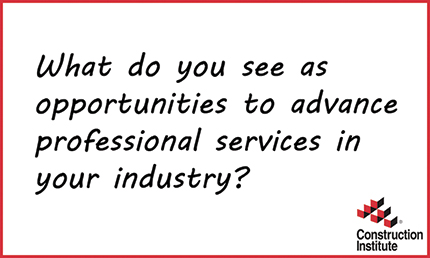
Contributors from the Connecticut AEC community
“Your vision of where or who you want to be is the greatest asset you have,” said Paul Arden. In this spirit, we asked members of the AEC industry to share their feedback on what they see as opportunities to advance professional services in our industry. With joy, we share what they have to say:
In my role as AIA Connecticut president, I continue to be amazed at the diversity and passion of the creative thought generated by our over 1,200 members. Architects are trained as leaders, problem solvers, communicators, and artists all-in-one. What this says to me is that our “Design Thinking” can be used not only to construct buildings, but to shepherd our society into it’s next phase, evolving us into a sustainable, resilient, and inclusive global community. Involving architects in activities such as research, policy writing, and strategic planning, will propel any public or private organization forward.
Angela Cahill, AIA, NOMA, NCARB, LEED AP – AIACT president and associate at QA+M Architecture
In order for architects to be effective advisors, advocates and stewards, we must continue to aid our clients in navigating often-competing challenges – from immediate issues (budget constraints, timing conflicts, program definition) to conceptual aspirations (ambitious vision, beautiful design) and long-term objectives (ease of maintenance, energy efficiency). The architectural profession will continue to be a poetic balance of imagination, art, design, and technical skill in the future.
Josye Utick, project designer & Associate at JCJ Architecture, AIA, NCARB, CDT
I am fortunate to have the opportunity to provide legal counsel to a diverse group of construction industry clients on projects of varying size and complexity, and have observed the increasing use of specialist professional services providers across the board. This trend seems to be driven in part by the continuing popularity of the construction manager at risk project delivery method, which motivates construction managers to bring in third party specialists who complement the skills of a project team, and the embrace of new technologies, which comes with the need for specialized technical knowledge to ensure smooth implementation. I think that the explosion of new technologies, like improvements on building information modelling systems, presents the biggest potential for growth in the provision of professional services to construction projects. For example, I recently worked with a consultant who provided video capture and integration services to integrate data captured by body-worn cameras into a final BIM-style model to create a type of “living” as-built model for use in future alterations and maintenance. This specialization didn’t exist until the last few years, and has created a new and increasingly popular niche professional service with further potential for growth within the same space and adjacent areas. As these types of imaging and modeling technologies become more efficient and affordable, I expect that the opportunities to provide innovative professional services will only increase.
Niel Franzese,construction attorney, Robinson+Cole
Poor communication among project participants is a continuing source of problems in the construction industry. Project mediators, sometimes called project neutrals, are professionals who facilitate communication and assist project participants in solving issues before they become disputes that contribute to cost overruns and delays. Project neutrals are used regularly by companies like Intel to keep project participants working together and keep projects on track. In the past, project neutrals and the more formal Dispute Review Boards were only used for large capital projects. Technology, in the form of videoconferencing, drones, and document sharing, make the use of project neutrals more cost-effective and available to a wider range of projects.
Nancy Greenwald, Construction Institute executive director
Interdisciplinary collaboration is a powerful force in the future of the AEC industry. With greater ties between architecture, science, medicine, and education, I believe that our experience of the built environment and its critical role in sustainability and public health will continue to unfold. From newly invented building materials fabricated in partnership with chemists and environmental scientists, to the WELL Building Standard – peer reviewed by scientists, medical practitioners, and designers – we are standing at the threshold of a transformational opportunity to advance professional services within the AEC industry.
Antonia Ciaverella, EDAC, WELL AP, LEED AP BD+C, Fitwel – architectural designer at Tecton Architects
The Construction Institute is grateful for these contributions, and the opportunity to be part of the advancement of the AEC Industry.








